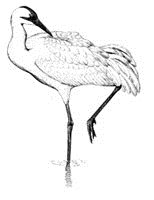North American Crane Working Group

Proceedings of the North American Crane Workshop
Date of this Version
2023
Document Type
Article
Citation
Proceedings of the North American Crane Workshop (2023) 16: 52–68
Abstract
We studied Whooping crane (Grus americana) nesting behavior and movement patterns at Wood Buffalo National Park using an instantaneous scan sampling approach. We also photo-documented important behavioral and ecological observations. Data were collected from 2 to 9 June 2023 from before 3:00 to after 22:00 hours. We completed 88 hours of observation and documented nest swapping about every 3.2 hours. The female incubated/brooded 3.3-10.9% more than the male, and the probability of incubation/brooding declined by 49% after the second chick began pipping and by 99% after both chicks had hatched. The eldest chick was successfully provisioned 16 hours and 33 minutes after hatching. The provisioning rate declined from morning to evening and increased with time since hatch. Parents stayed significantly closer to the elder chick (x̄ = 0.32 m) than the second chick (x̄ = 6.70 m), despite the first moving 9% further from the nest per hour after hatch. The second chick hatched nearly 40 hours after the first. The eldest chick consumed mainly Odonata spp. and Araneae spp. Adults had a more diverse diet that also included snails (Gastropoda spp.), small fish (Osteichthyes spp.), leeches (Hirudinea spp.), and biting flies (Diptera spp.). The male appeared flightless with only a couple of primary feathers remaining on each wing when the eldest chick hatched. We also describe the features of the whooping crane breeding site and the associated avian community. Though insights are based on data from a single nest, they provide a rich description that can improve our understanding of nesting ecology in a remote landscape.


Comments
Copyright 2025, North American Crane Working Group. Used by permission